


For the first part of my records of the Mendelssohn family history - 1850s-1951 return to
CHAPTER 1: MENDELSSOHN FAMILY PART 1
CHAPTER 2: MENDELSSOHN FAMILY PART 2
CHAPTER 6: THE STORY OF MORRIS (DE SAXE)

AND
Red Jos Blogspot


General surprise and regret were felt in Johannesburg yesterday when private advices were received stating that Mr Emanuel Mendelssohn had died when on the homeward voyage on the Kenilworth Castle and had been buried at sea. No information is available beyond the facts stated, and at the time of leaving the Rand Mr Mendelssohn appeared to be in the best of health.
Mr Mendelssohn, who was German by birth, went as a young man to Australia, and in the early eighties came to Queenstown, Cape Colony. Somewhere about 1887 he came to the Rand, bringing with him on a bullock wagon a wood and iron house, which he erected on a spot near the present Moseley Buildings, in President Street. His first business venture here was in Simmonds Street, but he will be best remembered because of his association with the Standard and Diggers News, in partnership with Mr Scott of the Standard, both tri-weeklies, which then in combination came out as a daily.
The two opened up a store in Market Street close to what is now the stage entrance to the Standard Theatre and on ground that is now occupied by the Post Office, and this was at one time the leading emporium for pianos and organs in Johannesburg. These two businesses were carried on by the partnership, as was also the newspaper printed in Harrison Street, not a hundred yards from the present Leader office and close to the boundary of the Wemmer Mine.
The News and the Mining Argus were until 1895 the two leading morning papers, but subsequently the latter became merged in the Johannesburg Times, inaugurated by Mr J B Robinson. The partners formed a syndicate to take up gold farms, which were eventually disposed of to the Ekstein Group.
Ten years ago Mr Scott left the Business and Mr Bruce, who was conducting the Transvaal Advertiser, joined Mr Mendelssohn in conducting the Standard and Diggers News, which went on successfully till the disturbance consequent on the Reform Movement. Mr Mendelssohn then went to England with the idea of starting a London edition of the paper, and in this project had the encouragement and support of Dr Leyds. Returning to the Rand before the declaration of war, he remained in the town till the advent of Lord Roberts and the troops. About two years ago he returned to the Rand. Mining again claimed his attention and it was in connection with the flotation of a diamond proposition that he left here for London only a few weeks ago. Mr Mendelssohn, who was 60 years of age, leaves many relatives on the Rand. He leaves a widow and five children, all grown up.
Mr Mendelssohn was keenly interested in the religious and educational progress of the Jewish Community. His death will be much regretted by a large section of the population, and his vigorous personality will be greatly missed.
References:- SA Jewish Year Book 1929. The Jews in SA - Saron and Hotz pps, 148, 163, 167, 169, 187(correspondence between E Mendelssohn and SL Heymann and Dr Hertz in the Transvaal Leader 2/3/05 and 6/3/05), 190, 197, 198. Pictorial History of Johannesburg pps. 20, 39.
The following is an extract of what is probably the Dictionary of South African Biography, but this needs confirmation.
Mendelssohn, Emmanuel (sic) (*Berlin, Ger., November 1850 - +at sea, 30.4.1910), newspaper proprietor, was the son of Itsich and Caroline Mendelssohn who lived in Berlin, where M. probably met his future wife, Caroline (Carrie), an Australian Soprano who studied at the Berlin Conservatoire of Music.
A certain amount of mystery surrounds Ms early years. It is possible that he married in Melbourne, Australia. In 1878 his wife, using the professional name of Madame Mendelssohn, formed a concert party and toured the Eastern Cape Colony. In the meantime M. had been surveying the commercial prospects of the Cape Colony and in March 1881 started a music warehouse in Queenstown which he ran till approximately 1887, subsequently opening up branches in East London and King Williams Town.
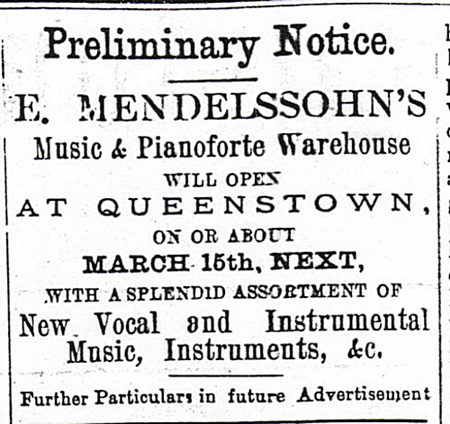
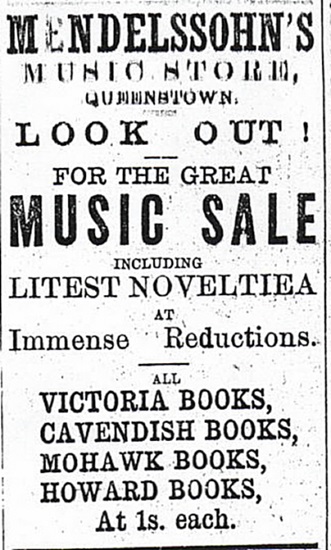

His pioneering spirit also led him to begin publishing a short-lived musical periodical The Cape Musical Monthly in March 1884.
With the discovery of gold on the Witwatersrand M. and his partner, Robert Stewart Scott, announced on 1.2.1887 that they intended starting a business in Johannesburg as a firm of printers, booksellers and stationers. In true pioneering spirit they soon established a thriving commercial empire. On 12.3.1887 they launched the newspaper The Standard and Transvaal Mining Chronicle, of which the last extant copy was printed on 8.4.1890. After that it apparently merged with The Standard and Diggers News from January 1891 to 31.5.1900. A special London edition also existed. In 1891 M. and Scott were directors of the Standard Building Society which launched a syndicate to build the Standard Theatre, inaugurated on 12.10.1891 and said to have been at the time the most magnificent theatre in South Africa. Madame Mendelssohn continued her singing career in Hohannesburg, and a highlight occurred on 15.7.1893 when she appeared with the world-famous bass, Signor Foli (Allen James Foley) who was touring South Africa.
Mystery again surrounds the final years of the Mendelssohn family. Possibly owing to the outbreak of the Second Anglo-Boer War (1899-1902) they disappeared from the South African scene, although M. retained considerable business interests here. In 1904 he was in Johannesburg, and was president of the first Rand and South African Jewish congregation.
In April 1910, while on his way to England, he died on board the Kenilworth Castle. His wife spent her last years in England and died on 18.1.1916 in London. In that year she had three married daughters in Manchester, two sons in America, while a fourth daughter had died earlier in Melbourne, Australia, in 1902.
C.G.Henning (Transvaal Arch., Pta; Death pap. E. Mendelssohn, no. 15782; Caroline Mendelssohn, no.28838; - Advertisements and Concert Reviews: The Eastern Province Herald, 2.6.1879; Queenstown Free Press, Nov. 1879; 9.3.1881 - 15.10.1886; 1.2.1887; The Star, 30.3.1889; 4.4.1889; - E. ROSENTHAL (comp.), Southern African dictionary of national biography, Lond., 1966; - L.WOLPOWITZ, James and Kate Hyde and the development of music up to the First World War, Pta., 1969.)
The following is an extract on page 41 of the abovementioned Wolpowitz book:
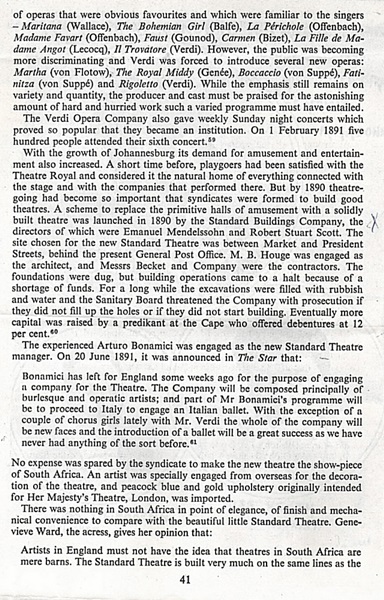
This next illustration, also from the Wolpowitz book, is from the 8 October 1898 "Standard and Diggers News" in Johannesburg records President Paul Kruger's birthday.
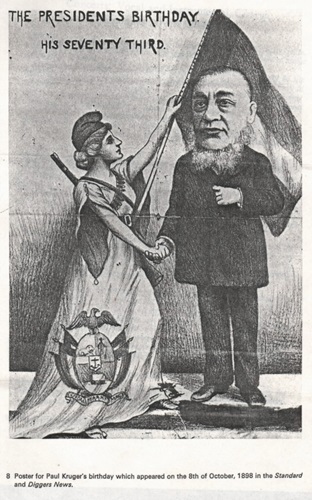

The following biographical item has this note handwritten at the bottom - but no date to indicate when it was written: "Dear Chief Rabbi, This is my brother Leo's short biography of Emanuel Mendelsohn (sic), Yours truly, Siegfried Raphaely [E.M. was grandfather of Morris deSaxe (sic) editor of our Jewish Year book 1929]":
EMANUEL MENDELSOHN (sic), J.P.
Born 1850 - Died 1910
In 1867 he and two brothers went to New Zealand, were shipwrecked, and he was the only survivor of the 3.
In 1875 married Carie (sic) Emmanuel (sic), then one of the prominent Singers of Australia.
They went over to Europe in 1878 where she sang at the Queen's Hall, London, and at the Berlin Music Academy.
They came to South Africa early in 1879, started a music business in Queenstown.
Left for Johannesburg in 1887, where together with R.S.Scott he started the "Standard Newspaper".
Was one of the foundation members of the Johannesburg Building Society, and President of the Witwatersrand Hebrew Congregation.
In 1895 he amalgamated with the "Diggers News", running the paper subsequently as the "Standard and Diggers News", which was later taken over by the "Daily Mail".
Imported the first Goss Printing Machine in 1898 to South Africa.
Remained there during the Boer War, and went to England in 1904 where he resided until 1910, in which year he came out to South Africa again, but died on board the "Kenilworth Castle" on his way back to England.
He was survived by 3 daughters, one of which is still living, Mrs. Kostoris of Manchester, and 2 sons.

The following article is an extract from JOHANNESBURG STREET NAMES - A DICTIONARY OF STREET, SUBURB AND OTHER PLACE-NAMES, COMPILED TO THE END OF 1968 - by Anna H. Smith, City Librarian, Johannesburg, and published by Juta & Company, Limited, in 1971.
This, the most thickly populated suburb, is situated in Randjeslaagte and on 13 July 1893 the court decided that the claims on this ground belonged to one J. Nicholls. He disopsed of them to the Transvall Mortgage, Loan and Finance Co., Ltd. with which Sam Goldreich and Emanuel Mendelssohn were associated.
In 1894 W.C.v.d.Sterr surveyed the ground and on 20 May 1895 S. Meintjes (on behalf of the company) received permission to change the claims into stands. This information was given to the Second Volksraad on 17 June 1897. (Notulen, p.709).
In the Town Engineer's Report for the Year ending 31st December 1895 it is stated that 'in the early part of the year the open ground to the North of Pretoria Street and East of Banket Street, now called Hillbrow, was laid into stands.' At that time this area was almost entirely outside the jurisdiction of the Town. The Critic of 21 June 1895 (p.116) calls it Hillbrow Residential Estate.
On 22 June 1895 the weekly edition of The Standard and Diggers' News advertised the sale of this estate and described it as the 'property . . . . on the brow of Hospital Hill extending to Park Town and Berea Estate'. From this one assumes that the name is descriptive, and Mr. John Mendelssohn, grandson of one of the township-owners, confirmed this on 8 November 1960. As Mr. Emanuel Mendelssohn was also connected with The Standard and Diggers' News, the sale of the Hillbrow stands received much publicity, as is evident from the following passage taken from the issue for 22 July 1895 - two days before the sale:
'On Saturday, at the invitation of Mr. S. Goldreich, a party of 30 or 40 gentlemen visited the site of Johannesburg's latest projected suburb, for the purpose of inspecting the ground prior to the date of sale. The company included Messrs. S. Goldreich (who acted as guide, philosopher and friend), E.Mendelssohn, W. Bruce, C.D.Baynes, T.Sheffield, G.A.Cook, J.H.Goldreich, Hoyle, C.Webb, H.J.Humphrey, R.Currie, Smit (Assistant Mining Commissioner), and Nicholl.
Having made a thorough inspection of the ground, and viewed the scenery, which it would be difficult to excel in the vicinity of Johannesburg the party turned their backs on Hillbrow, unanimous in the opinion that the new and elevated suburb is capitally situated, and bound to become a popular residential portion of the town. From Hillbrow the party were conveyed to the Freemasons' Hall, in Jeppe Street, where an excellent lunch was provided by Mr. Schroeder, and presided over by Mr.E.Mendelssohn, after which a number of toasts were proposed and enthusiastically drunk in bumpers of champagne. The toasts included the Hillbrow Estate, which was proposed in glowing terms by Mr.S.Goldreich; the Rand Provident Building Society, in which society Mr. Goldreich is the largest shareholder, and which hopes to be the means of enabling purchasers of Hillbrow stands to erect buildings thereon; the Auctioneers, the Surveyor, the Assistant Mining Commissioner, the Press and Mr. Goldreich and the gentlemen associated with him in the Hillbrow township.
All the speakers referred in flattering terms to the prospects of Hillbrow, more especially Mr. Richard Currie, who expressed the opinion, based on a long experience of property on the Rand, that the sale of Hillbrow stands on Wednesday will be the most successful sale of the kind that has ever taken place in Johannesburg. No one could possibly forsee the great possibilities of the Rand, and he had no hesitation in saying that as the gold mining industry increased so would the value of property in Johannesburg proportionately increase.'
On 25 July 1895 the same paper published a lengthy report on the sale, listing not only the names of the buyers of the stands but also the prices paid for each.
'Yesterday morning Mr. Richard Currie held the long expected sale of the Hillbrow residential plots, and at the time of commencement, 10 o'clock, there was a good attendance of buyers who stood unflinchingly in the hot sun eagerly competing for the ground in what will, undoubtedly, be Johannesburg's chief and most fashionable suburb in the near future. The sale had, of course, been well advertised, and as a consequence for the last three weeks intending purchasers have been continually visiting the site; and the situation was found to be so charming, standing as it does high up, and in the cases of very many of the plots, with such grand views of the whole of the Golden City, that competition was sure to be keen.
Consequently the highest lots, whether they were on a quarry or a heap of rocks, were quickly run up in price in a manner that must have greatly encouraged the genial and able auctioneer who wielded the hammer with such success. The conditions of sale having been read by the auctioneer, chief amongst which was the provision that no store, canteen, or any other business should be carried on on the ground, except so far as was provided on the one set of stands reserved for an hotel, it was then explained that the title was a Government title direct, and that the sale was absolutely without reserve. The lower stands on the rocks in Ockerse Street were first put up, and business continued very brisk until the adjournment for lunch at one o'clock no less than 210 stands having been then disposed of for the sum of 32,000 pounds.
In the afternoon, when only the further stands remained, and those in the dip, the prices fell off considerably, but even though sales were effected as low as 55 pounds, the general average of the day was certainly very satisfactory to both sellers and auctioneer. On the conclusion of the sale the representative of the STANDARD AND DIGGERS' NEWS had some conversation with Mr. Currie. He considered the general average of prices that had been realised to be very satisfactory, although he had to confess to some disappointment with the later part of the afternoon. He had expected a high average, because Hillbrow was, he considered, going to become the fashionable residential suburb of Johannesburg. Doornfontien was all taken up and stands could not be bought there under 300 pounds. Jeppestown was full, and the City and Suburban Township was to be an industrial quarter of the town.
The tendency of the town was undoubtedly in the general direction of Hillbrow, and on the one side it was the Parktown Estate with its large houses, and on the other the Berea Estate, which was being so carefully laid out and nursed for big prices. The people who had attended and bought were chiefly investors and those buying for their own occupation, and the fact of the conditions of sale precluding the establishment of canteens and stores was in itself a great inducement to purchasers. Mr. Currie was convinced that Johannesburg was yet only in the early beginnings, and the value of the stands would largely increase as the best residential place, and situated within a mile-and-a-half of the Chains.'
On 5 March 1897 the Executive Council of the South African Republic agreed to place Hillbrow under the jurisdiction of the Johannesburg Sanitary Board - the local authority of those days. This was at the request of the tenants and owners. Hillbrow is not a township in its own right, but part of the township of Johannesburg. If the report of the first Town Council (1897) has been correctly interpreted, the northern portion of Hillbrow became part of the municipal area on 5 March 1897, and the southern part earlier.

In 1971 Anna Smith, Johannesburg City Librarian, had published (Juta and Company Limited, 1971) JOHANNESBURG STREET NAMES A DICTIONARY OF STREET, SUBURB AND OTHER PLACE NAMES, COMPILED TO THE END OF 1968.
The following entry appeared on page 77:
CAROLINE STREET, Hillbrow
Mrs.E.Klagsbrun - niece of Emmanuel (sic) Mendelssohn - stated on 24 September 1960 that the street was named after Mrs. Caroline Mendelssohn, wife of Emmanuel (sic) Mendelssohn, the township owner. Mr. John Mendelssohn (grandson) confirmed this on 8 November 1960.

Photos by Mannie De Saxe, Brixton Cemetery, Johannesburg, 1977. I was leaving for Australia early in 1978, and as I had never been to visit my father's grave at Brixton Cemetery, I went on my first visit and took these photos.

Photos by Ken Davis, Brixton Cemetery, Johannesburg, 1998. Ken took these photos, at my request, on one of his many trips to South Africa
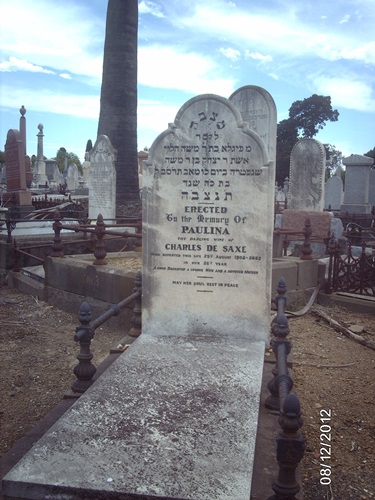
Paulina's death certificate
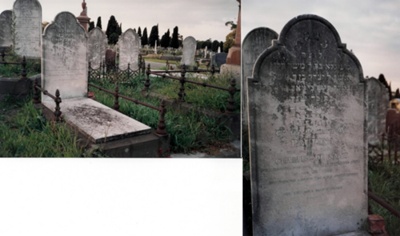
These photos - taken by Mannie De Saxe in 1991 - were when the grave of Paulina De Saxe was first found in Melbourne General Cemetery after a long search around the Jewish part of the cemetery. The head stone was in a very bad condition, and the lettering, after nearly 100 years of neglect, was just about illegible.
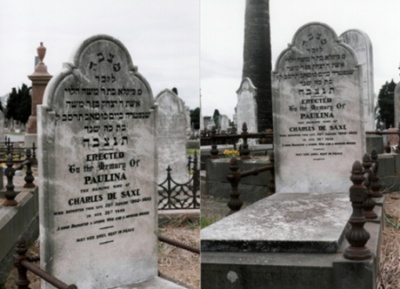
Kendall Lovett and Mannie De Saxe painted the lettering on Paulina De Saxe's head stone in 1998, and took these photos.
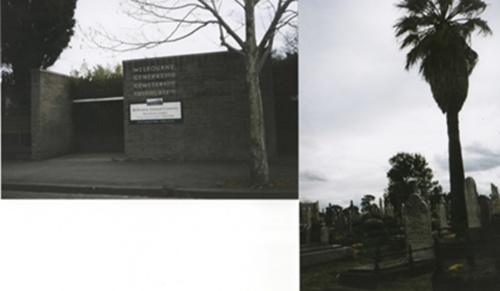 There is only one palm tree in the whole of the grounds of Melbourne General Cemetery, and Paulina De Saxe's grave stone is right next to it, so it is easy to locate. These two photos show one of the entrances to the Cemetery and the position of Paulina's grave stone.
There is only one palm tree in the whole of the grounds of Melbourne General Cemetery, and Paulina De Saxe's grave stone is right next to it, so it is easy to locate. These two photos show one of the entrances to the Cemetery and the position of Paulina's grave stone.
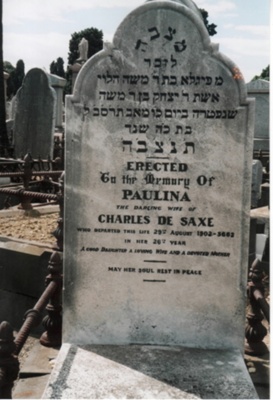 Paulina's grave in 2002
Paulina's grave in 2002Close-up view of Paulina De Saxe's grave in Melbourne General Cemetery when we visited it in 2002 to see how our paintwork had stood up to a few years of exposure to the Melbourne weather. It seems to have done remarkably well.
Photos by Kendall Lovett, Melbourne General Cemetery, 28 August 2002
TO REMEMBER THE SHORT LIFE OF PAULINA DE SAXE, BORN MENDELSSOHN, BORN 19 JUNE 1877 IN BRISBANE, QUEENSLAND, DIED IN MELBOURNE, VICTORIA 29 AUGUST 1902, AGED 25.
TO REMEMBER ALSO THE SHORT LIFE OF HER SON, MORRIS ISAAC DE SAXE, BORN MELBOURNE, VICTORIA, 23 OCTOBER 1898, AND DIED 28 AUGUST 1930 IN JOHANNESBURG, SOUTH AFRICA, AGED 31.
PAULINA DIDN'T KNOW HER SONS' LIVES, AND HER SECOND SON, WILFRED EMANUEL DE SAXE, BORN MELBOURNE, VICTORIA, 28 APRIL 1900, DISAPPEARED WITHOUT TRACE AFTER ABOUT 1904. IN MEMORY OF WILFRED.
MORRIS ISAAC DE SAXE HAD TWO CHILDREN, JEANNETTE MOLLY, BORN JOHANNESBURG 18 MARCH 1924, AND EMANUEL JOSHUA, BORN JOHANNESBURG 30 OCTOBER 1926.
PAULINA AND MORRIS ARE REMEMBERED ON THE 100TH ANNIVERSARY OF PAULINA'S DEATH AND THE 72ND ANNIVERSARY OF MORRIS'S DEATH BY GRANDSON AND SON, MANNIE (EMANUEL) DE SAXE AND HIS PARTNER KENDALL LOVETT.
28 AND 29 AUGUST 2002
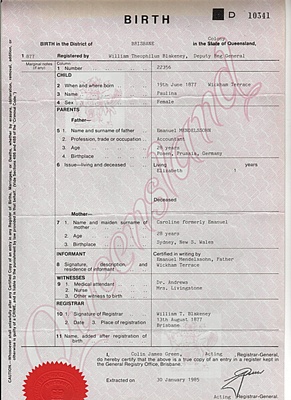

(information provided by Ann Mitchell on 19 October 2008 with the statement that some of the data provided needs confirmation.).

CHAPTER 1: MENDELSSOHN FAMILY PART 1
CHAPTER 2: MENDELSSOHN FAMILY PART 2
CHAPTER 6: THE STORY OF MORRIS (DE SAXE)


Mannie and Kendall Present: LESBIAN AND GAY SOLIDARITY ACTIVISMS
RED JOS:HUMAN RIGHTS ACTIVISMMannie's weblogs may be accessed directly by clicking on to the following links
Activist Kicks Backs - Blognow archive re-housed - 2005-2009
Red Jos Blogspot
Genealogy only Copyright ©: De Saxe Family
This page updated 6 SEPTEMBER 2013 and again on 25 OCTOBER 2016
PAGE 46